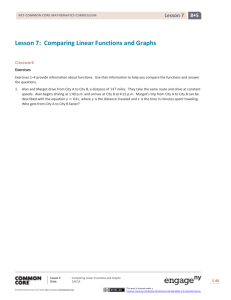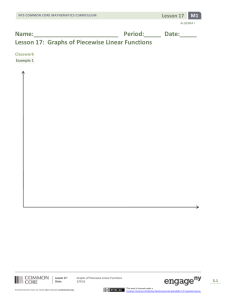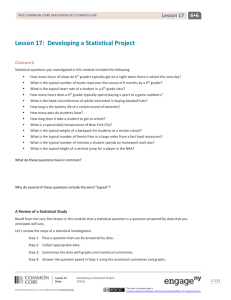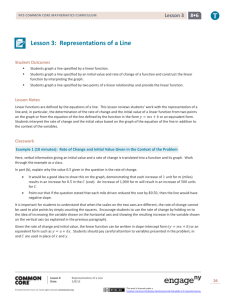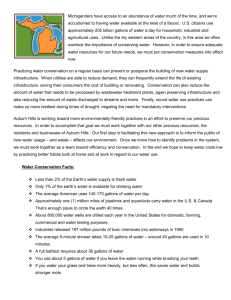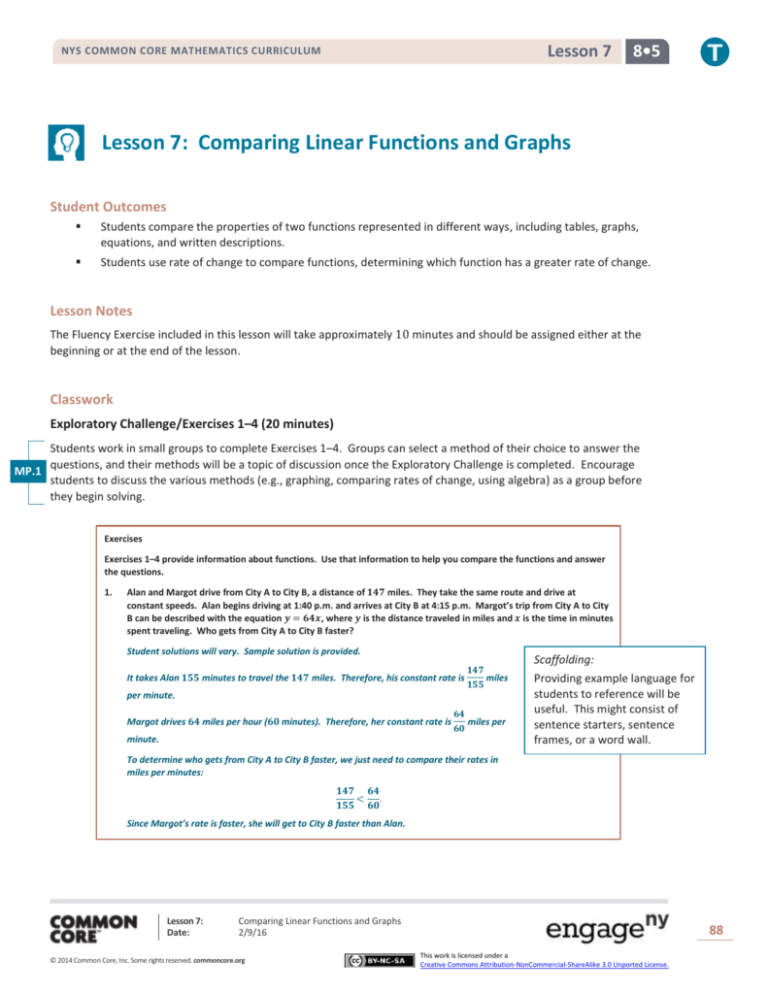
Lesson 7
NYS COMMON CORE MATHEMATICS CURRICULUM
8•5
Lesson 7: Comparing Linear Functions and Graphs
Student Outcomes
Students compare the properties of two functions represented in different ways, including tables, graphs,
equations, and written descriptions.
Students use rate of change to compare functions, determining which function has a greater rate of change.
Lesson Notes
The Fluency Exercise included in this lesson will take approximately 10 minutes and should be assigned either at the
beginning or at the end of the lesson.
Classwork
Exploratory Challenge/Exercises 1–4 (20 minutes)
Students work in small groups to complete Exercises 1–4. Groups can select a method of their choice to answer the
questions, and their methods will be a topic of discussion once the Exploratory Challenge is completed. Encourage
MP.1
students to discuss the various methods (e.g., graphing, comparing rates of change, using algebra) as a group before
they begin solving.
Exercises
Exercises 1–4 provide information about functions. Use that information to help you compare the functions and answer
the questions.
1.
Alan and Margot drive from City A to City B, a distance of 𝟏𝟒𝟕 miles. They take the same route and drive at
constant speeds. Alan begins driving at 1:40 p.m. and arrives at City B at 4:15 p.m. Margot’s trip from City A to City
B can be described with the equation 𝒚 = 𝟔𝟒𝒙, where 𝒚 is the distance traveled in miles and 𝒙 is the time in minutes
spent traveling. Who gets from City A to City B faster?
Student solutions will vary. Sample solution is provided.
It takes Alan 𝟏𝟓𝟓 minutes to travel the 𝟏𝟒𝟕 miles. Therefore, his constant rate is
𝟏𝟒𝟕
𝟏𝟓𝟓
Scaffolding:
miles
per minute.
Margot drives 𝟔𝟒 miles per hour (𝟔𝟎 minutes). Therefore, her constant rate is
𝟔𝟒
𝟔𝟎
miles per
minute.
Providing example language for
students to reference will be
useful. This might consist of
sentence starters, sentence
frames, or a word wall.
To determine who gets from City A to City B faster, we just need to compare their rates in
miles per minutes:
𝟏𝟒𝟕 𝟔𝟒
< .
𝟏𝟓𝟓 𝟔𝟎
Since Margot’s rate is faster, she will get to City B faster than Alan.
Lesson 7:
Date:
Comparing Linear Functions and Graphs
2/9/16
© 2014 Common Core, Inc. Some rights reserved. commoncore.org
88
This work is licensed under a
Creative Commons Attribution-NonCommercial-ShareAlike 3.0 Unported License.
Lesson 7
NYS COMMON CORE MATHEMATICS CURRICULUM
2.
8•5
You have recently begun researching phone billing plans. Phone Company A charges a flat rate of $𝟕𝟓 a month. A
flat rate means that your bill will be $𝟕𝟓 each month with no additional costs. The billing plan for Phone Company B
is a linear function of the number of texts that you send that month. That is, the total cost of the bill changes each
month depending on how many texts you send. The table below represents the inputs and the corresponding
outputs that the function assigns.
Input
(number of texts)
Output
(cost of bill)
𝟓𝟎
$𝟓𝟎
𝟏𝟓𝟎
$𝟔𝟎
𝟐𝟎𝟎
$𝟔𝟓
𝟓𝟎𝟎
$𝟗𝟓
At what number of texts would the bill from each phone plan be the same? At what number of texts is Phone
Company A the better choice? At what number of texts is Phone Company B the better choice?
Student solutions will vary. Sample solution is provided.
The equation that represents the function for Phone Company A is 𝒚 = 𝟕𝟓.
To determine the equation that represents the function for Phone Company B, we need the rate of change:
𝟔𝟎 − 𝟓𝟎
𝟏𝟎
=
𝟏𝟓𝟎 − 𝟓𝟎 𝟏𝟎𝟎
𝟔𝟓 − 𝟔𝟎
𝟓
=
𝟐𝟎𝟎 − 𝟏𝟓𝟎 𝟓𝟎
= 𝟎. 𝟏
𝟗𝟓 − 𝟔𝟓
𝟑𝟎
=
𝟓𝟎𝟎 − 𝟐𝟎𝟎 𝟑𝟎𝟎
= 𝟎. 𝟏
= 𝟎. 𝟏
The equation for Phone Company B is shown below.
Using the assignment of 𝟓𝟎 to 𝟓𝟎,
𝟓𝟎 = 𝟎. 𝟏(𝟓𝟎) + 𝒃
𝟓𝟎 = 𝟓 + 𝒃
𝟒𝟓 = 𝒃.
The equation that represents the function for Phone Company B is 𝒚 = 𝟎. 𝟏𝒙 + 𝟒𝟓.
We can determine at what point the phone companies charge the same amount by solving the system:
𝒚 = 𝟕𝟓
{
𝒚 = 𝟎. 𝟏𝒙 + 𝟒𝟓
𝟕𝟓 = 𝟎. 𝟏𝒙 + 𝟒𝟓
𝟑𝟎 = 𝟎. 𝟏𝒙
𝟑𝟎𝟎 = 𝒙
After 𝟑𝟎𝟎 texts are sent, both companies would charge the same amount, $𝟕𝟓. More than 𝟑𝟎𝟎 texts means that
the bill from Phone Company B will be higher than Phone Company A. Less than 𝟑𝟎𝟎 texts means the bill from
Phone Company A will be higher.
Lesson 7:
Date:
Comparing Linear Functions and Graphs
2/9/16
© 2014 Common Core, Inc. Some rights reserved. commoncore.org
89
This work is licensed under a
Creative Commons Attribution-NonCommercial-ShareAlike 3.0 Unported License.
Lesson 7
NYS COMMON CORE MATHEMATICS CURRICULUM
3.
8•5
A function describes the volume of water, 𝒚, that flows from Faucet A in gallons for 𝒙 minutes. The graph below is
𝟓
𝟔
the graph of this linear function. Faucet B’s water flow can be described by the equation 𝒚 = 𝒙, where 𝒚 is the
volume of water in gallons that flows from the faucet in 𝒙 minutes. Assume the flow of water from each faucet is
constant. Which faucet has a faster rate of flow of water? Each faucet is being used to fill tubs with a volume of 𝟓𝟎
gallons. How long will it take each faucet to fill the tub? How do you know? The tub that is filled by Faucet A
already has 𝟏𝟓 gallons in it. If both faucets are turned on at the same time, which faucet will fill its tub faster?
Student solutions will vary. Sample solution is provided.
The slope of the graph of the line is
𝟒
𝟕
because (𝟕, 𝟒) is a point on the line that represents 𝟒 gallons of water that
𝟒
flows in 𝟕 minutes. Therefore, the rate of water flow for Faucet A is . To determine which faucet has a faster flow
𝟕
of water, we can compare their rates.
𝟒 𝟓
<
𝟕 𝟔
Therefore, Faucet B has a faster rate of water flow.
Faucet A
Faucet B
𝟓𝟎 =
𝟒
𝒙
𝟕
𝟓
𝒙
𝟔
𝟓
𝟓𝟎 = 𝒙
𝟔
𝟔
𝟓𝟎 ( ) = 𝒙
𝟓
𝟔𝟎 = 𝒙
𝒚=
𝟕
𝟓𝟎 ( ) = 𝒙
𝟒
𝟑𝟓𝟎
=𝒙
𝟒
𝟖𝟕. 𝟓 = 𝒙
It will take 𝟖𝟕. 𝟓 minutes to fill
a tub of 𝟓𝟎 gallons.
Lesson 7:
Date:
It will take 𝟔𝟎 minutes to fill a
tub of 𝟓𝟎 gallons.
The tub filled by Faucet A that already has
𝟏𝟓 gallons in it
𝟒
𝒙 + 𝟏𝟓
𝟕
𝟒
𝟑𝟓 = 𝒙
𝟕
𝟕
𝟑𝟓 ( ) = 𝒙
𝟒
𝟔𝟏. 𝟐𝟓 = 𝒙
𝟓𝟎 =
Faucet B will fill the tub first because it will
take Faucet A 𝟔𝟏. 𝟐𝟓 minutes to fill the
tub, even though it already has 𝟏𝟓 gallons
in it.
Comparing Linear Functions and Graphs
2/9/16
© 2014 Common Core, Inc. Some rights reserved. commoncore.org
90
This work is licensed under a
Creative Commons Attribution-NonCommercial-ShareAlike 3.0 Unported License.
Lesson 7
NYS COMMON CORE MATHEMATICS CURRICULUM
4.
8•5
Two people, Adam and Bianca, are competing to see who can save the most money in one month. Use the table
and the graph below to determine who will save more money at the end of the month. State how much money
each person had at the start of the competition.
Adam’s Savings:
Bianca’s Savings:
Input
(Number of Days)
Output
(Total amount of
money)
𝟓
$𝟏𝟕
𝟖
$𝟐𝟔
𝟏𝟐
$𝟑𝟖
𝟐𝟎
$𝟔𝟐
The slope of the line that represents Adam’s savings is 𝟑; therefore, the rate at which Adam is saving money is $𝟑
per day. According to the table of values for Bianca, she is also saving money at a rate of $𝟑 per day:
𝟐𝟔 − 𝟏𝟕 𝟗
= =𝟑
𝟖−𝟓
𝟑
𝟑𝟖 − 𝟐𝟔 𝟏𝟐
=
=𝟑
𝟏𝟐 − 𝟖
𝟒
𝟔𝟐 − 𝟐𝟔 𝟑𝟔
=
=𝟑
𝟐𝟎 − 𝟖
𝟏𝟐
Therefore, at the end of the month, Adam and Bianca will both have saved the same amount of money.
According to the graph for Adam, the equation 𝒚 = 𝟑𝒙 + 𝟑 represents the function of money saved each day. On
day zero, he must have had $𝟑.
The equation that represents the function of money saved each day for Bianca is 𝒚 = 𝟑𝒙 + 𝟐 because using the
assignment of 𝟏𝟕 to 𝟓:
𝟏𝟕 = 𝟑(𝟓) + 𝒃
𝟏𝟕 = 𝟏𝟓 + 𝒃
𝟐 = 𝒃.
The amount of money Bianca had on day zero is $𝟐.
Lesson 7:
Date:
Comparing Linear Functions and Graphs
2/9/16
© 2014 Common Core, Inc. Some rights reserved. commoncore.org
91
This work is licensed under a
Creative Commons Attribution-NonCommercial-ShareAlike 3.0 Unported License.
Lesson 7
NYS COMMON CORE MATHEMATICS CURRICULUM
8•5
Discussion (5 minutes)
To encourage students to compare different methods of solving problems and to make connections between them, ask
students to describe their methods for determining the answers to Exercises 1–4. Use the following questions to guide
the discussion.
MP.1
Was one method more efficient than the other? Does everyone agree? Why or why not?
How did you know which method was more efficient? Did you realize at the beginning of the problem or after
they finished?
Did you complete every problem using the same method? Why or why not?
Closing (5 minutes)
Summarize, or ask students to summarize, the main points from the lesson:
We know that functions can be expressed as equations, graphs, tables, and using verbal descriptions.
Regardless of the way that the function is expressed, we can compare it with another function.
We know that we can compare two functions using different methods. Some methods are more efficient than
others.
Exit Ticket (5 minutes)
Fluency Exercise (10 minutes): Multi-Step Equations II
RWBE: During this exercise, students will solve nine multi-step equations. Each equation should be solved in about a
minute. Consider having students work on white boards, showing you their solutions after each problem is assigned.
The nine equations and their answers are below. Refer to the Rapid White Board Exchanges section in the Module
Overview for directions to administer a RWBE.
Lesson 7:
Date:
Comparing Linear Functions and Graphs
2/9/16
© 2014 Common Core, Inc. Some rights reserved. commoncore.org
92
This work is licensed under a
Creative Commons Attribution-NonCommercial-ShareAlike 3.0 Unported License.
Lesson 7
NYS COMMON CORE MATHEMATICS CURRICULUM
Name
8•5
Date
Lesson 7: Comparing Linear Functions and Graphs
Exit Ticket
Brothers, Paul and Pete, walk 2 miles to school from home. Paul can walk to school in 24 minutes. Pete has slept in
again and needs to run to school. Paul walks at constant rate, and Pete runs at a constant rate. The graph of the
function that represents Pete’s run is shown below.
a.
Which brother is moving at a greater rate? Explain how you know.
b.
If Pete leaves 5 minutes after Paul, will he catch Paul before they get
to school?
Lesson 7:
Date:
Comparing Linear Functions and Graphs
2/9/16
© 2014 Common Core, Inc. Some rights reserved. commoncore.org
93
This work is licensed under a
Creative Commons Attribution-NonCommercial-ShareAlike 3.0 Unported License.
Lesson 7
NYS COMMON CORE MATHEMATICS CURRICULUM
8•5
Exit Ticket Sample Solutions
Brothers, Paul and Pete, walk 𝟐 miles to school from home. Paul can walk to school in 𝟐𝟒 minutes. Pete has slept in
again and needs to run to school. Paul walks at constant rate, and Pete runs at a constant rate. The graph of the function
that represents Pete’s run is shown below.
a.
Which brother is moving at a greater rate? Explain how you know.
Paul takes 𝟐𝟒 minutes to walk 𝟐 miles; therefore, his rate is
Pete can run 𝟖 miles in 𝟔𝟎 minutes; therefore, his rate is
Since
b.
𝟐
𝟏𝟓
>
𝟏
𝟖
𝟏
.
𝟏𝟐
, or
𝟔𝟎
𝟐
𝟏𝟓
.
, Pete is moving at a greater rate.
𝟏𝟐
If Pete leaves 𝟓 minutes after Paul, will he catch Paul before they
get to school?
Student solution methods will vary. Sample answer is shown.
Since Pete slept in, we need to account for that fact. So, Pete’s
time would be decreased. The equation that would represent the
number of miles Pete walks, 𝒚, walked in 𝒙 minutes, would be
𝒚=
𝟐
(𝒙 − 𝟓).
𝟏𝟓
The equation that would represent the number of miles Paul runs, 𝒚, run in 𝒙 minutes, would be 𝒚 =
𝟏
𝒙.
𝟏𝟐
To find out when they meet, solve the system of equations:
𝟐
𝟐
𝒙−
𝟏𝟓
𝟑
{
𝟏
𝒚=
𝒙
𝟏𝟐
𝟐
𝟐
𝟏
𝒙− =
𝒙
𝟏𝟓
𝟑 𝟏𝟐
𝟐
𝟐 𝟏
𝟐
𝟏
𝟏
𝟐
𝒙− −
𝒙+ =
𝒙−
𝒙+
𝟏𝟓
𝟑 𝟏𝟐
𝟑 𝟏𝟐
𝟏𝟐
𝟑
𝟏
𝟐
𝒙=
𝟐𝟎
𝟑
𝟐𝟎 𝟏
𝟐 𝟐𝟎
( )
𝒙= ( )
𝟏 𝟐𝟎
𝟑 𝟏
𝟒𝟎
𝒙=𝒙
𝟑
𝟐 𝟒𝟎
𝟐
or
𝒚=
( )−
𝟏𝟓 𝟑
𝟑
𝒚=
𝟒𝟎
𝟏𝟎
𝒚=( )=
𝟑
𝟗
Pete would catch up to Paul in
𝟒𝟎
𝟗
minutes, which is equal to
𝟏𝟎
𝟗
miles. Yes, he will catch Paul before they get
to school because it is less than the total distance, two miles, to school.
Lesson 7:
Date:
Comparing Linear Functions and Graphs
2/9/16
© 2014 Common Core, Inc. Some rights reserved. commoncore.org
94
This work is licensed under a
Creative Commons Attribution-NonCommercial-ShareAlike 3.0 Unported License.
Lesson 7
NYS COMMON CORE MATHEMATICS CURRICULUM
8•5
Problem Set Sample Solutions
1.
The graph below represents the distance, 𝒚, Car A travels in 𝒙 minutes. The table represents the distance, 𝒚, Car B
travels in 𝒙 minutes. Which car is traveling at a greater speed? How do you know?
Car A:
Car B:
Time in minutes
(𝒙)
Distance
(𝒚)
𝟏𝟓
𝟏𝟐. 𝟓
𝟑𝟎
𝟐𝟓
𝟒𝟓
𝟑𝟕. 𝟓
𝟐
𝟑
Based on the graph, Car A is traveling at a rate of 𝟐 miles every 𝟑 minutes, 𝒎 = . From the table, the rate that Car
B is traveling is constant, as shown below.
𝟐𝟓 − 𝟏𝟐. 𝟓 𝟏𝟐. 𝟓 𝟐𝟓 𝟓
=
=
=
𝟑𝟎 − 𝟏𝟓
𝟏𝟓
𝟑𝟎 𝟔
𝟑𝟕. 𝟓 − 𝟐𝟓 𝟏𝟐. 𝟓 𝟓
=
=
𝟒𝟓 − 𝟑𝟎
𝟏𝟓
𝟔
𝟑𝟕. 𝟓 − 𝟏𝟐. 𝟓 𝟐𝟓 𝟓
=
=
𝟒𝟓 − 𝟏𝟓
𝟑𝟎 𝟔
Since
𝟓
𝟔
𝟐
> , Car B is traveling at a greater speed.
𝟑
Lesson 7:
Date:
Comparing Linear Functions and Graphs
2/9/16
© 2014 Common Core, Inc. Some rights reserved. commoncore.org
95
This work is licensed under a
Creative Commons Attribution-NonCommercial-ShareAlike 3.0 Unported License.
Lesson 7
NYS COMMON CORE MATHEMATICS CURRICULUM
2.
8•5
The local park needs to replace an existing fence that is 𝟔 feet high. Fence Company A charges $𝟕, 𝟎𝟎𝟎 for building
materials and $𝟐𝟎𝟎 per foot for the length of the fence. Fence Company B charges based on the length of the fence.
That is, the total cost of the 𝟔-foot high fence will depend on how long the fence is. The table below represents the
inputs and the corresponding outputs that the function for Fence Company B assigns.
a.
Input
(length of fence)
Output
(cost of bill)
𝟏𝟎𝟎
$𝟐𝟔, 𝟎𝟎𝟎
𝟏𝟐𝟎
$𝟑𝟏, 𝟐𝟎𝟎
𝟏𝟖𝟎
$𝟒𝟔, 𝟖𝟎𝟎
𝟐𝟓𝟎
$𝟔𝟓, 𝟎𝟎𝟎
Which company charges a higher rate per foot of fencing? How do you know?
Let 𝒙 represent the length of the fence and 𝒚 represent the total cost.
The equation that represents the function for Fence Company A is 𝒚 = 𝟐𝟎𝟎𝒙 + 𝟕, 𝟎𝟎𝟎. So, the rate is 𝟐𝟎𝟎.
The rate of change for Fence Company B:
𝟐𝟔, 𝟎𝟎𝟎 − 𝟑𝟏, 𝟐𝟎𝟎 −𝟓, 𝟐𝟎𝟎
=
𝟏𝟎𝟎 − 𝟏𝟐𝟎
−𝟐𝟎
𝟑𝟏, 𝟐𝟎𝟎 − 𝟒𝟔, 𝟖𝟎𝟎 −𝟏𝟓, 𝟔𝟎𝟎
=
𝟏𝟐𝟎 − 𝟏𝟖𝟎
−𝟔𝟎
= 𝟐𝟔𝟎
𝟒𝟔, 𝟖𝟎𝟎 − 𝟔𝟓, 𝟎𝟎𝟎 −𝟏𝟖, 𝟐𝟎𝟎
=
𝟏𝟖𝟎 − 𝟐𝟓𝟎
−𝟕𝟎
= 𝟐𝟔𝟎
= 𝟐𝟔𝟎
Fence Company B charges a higher rate per foot because when you compare the rates, 𝟐𝟔𝟎 > 𝟐𝟎𝟎.
b.
At what number of the length of the fence would the cost from each fence company be the same? What will
the cost be when the companies charge the same amount? If the fence you need is 𝟏𝟗𝟎 feet in length, which
company would be a better choice?
Student solutions will vary. Sample solution is provided.
The equation for Fence Company B is
𝒚 = 𝟐𝟔𝟎𝒙.
We can find out at what point the fence companies charge the same amount by solving the system:
{
𝒚 = 𝟐𝟎𝟎𝒙 + 𝟕𝟎𝟎𝟎
𝒚 = 𝟐𝟔𝟎𝒙
𝟐𝟎𝟎𝒙 + 𝟕, 𝟎𝟎𝟎 = 𝟐𝟔𝟎𝒙
𝟕, 𝟎𝟎𝟎 = 𝟔𝟎𝒙
𝟏𝟏𝟔. 𝟔𝟔𝟔𝟔 … . . . = 𝒙
𝟏𝟏𝟔. 𝟔 ≈ 𝒙
At 𝟏𝟏𝟔. 𝟔 feet of fencing, both companies would charge the same amount (about $𝟑𝟎, 𝟑𝟐𝟎). Less than
𝟏𝟏𝟔. 𝟔 feet of fencing means that the cost from Fence Company A will be more than Fence Company B. More
than 𝟏𝟏𝟔. 𝟔 feet of fencing means that the cost from Fence Company B will be more than Fence Company A.
So, for 𝟏𝟗𝟎 feet of fencing, Fence Company A is the better choice.
Lesson 7:
Date:
Comparing Linear Functions and Graphs
2/9/16
© 2014 Common Core, Inc. Some rights reserved. commoncore.org
96
This work is licensed under a
Creative Commons Attribution-NonCommercial-ShareAlike 3.0 Unported License.
Lesson 7
NYS COMMON CORE MATHEMATICS CURRICULUM
3.
8•5
The rule 𝒚 = 𝟏𝟐𝟑𝒙 is used to describe the function for the number of minutes needed, 𝒙, to produce 𝒚 toys at Toys
Plus. Another company, #1 Toys, has a similar function that assigned the values shown in the table below. Which
company produces toys at a slower rate? Explain.
Time in minutes
(𝒙)
Toys Produced
(𝒚)
𝟓
𝟔𝟎𝟎
𝟏𝟏
𝟏, 𝟑𝟐𝟎
𝟏𝟑
𝟏, 𝟓𝟔𝟎
#1 Toys produces toys at a constant rate because the data in the table increases at a constant rate, as shown below.
𝟏, 𝟑𝟐𝟎 − 𝟔𝟎𝟎 𝟕𝟐𝟎
=
𝟏𝟏 − 𝟓
𝟔
𝟏, 𝟓𝟔𝟎 − 𝟔𝟎𝟎 𝟗𝟔𝟎
=
𝟏𝟑 − 𝟓
𝟖
𝟏, 𝟓𝟔𝟎 − 𝟏, 𝟑𝟐𝟎 𝟐𝟒𝟎
=
𝟏𝟑 − 𝟏𝟏
𝟐
= 𝟏𝟐𝟎
= 𝟏𝟐𝟎
= 𝟏𝟐𝟎
The rate of production for Toys Plus is 𝟏𝟐𝟑 and for #1 Toys is 𝟏𝟐𝟎. Since 𝟏𝟐𝟎 < 𝟏𝟐𝟑, #1 Toys produces toys at a
slower rate.
4.
A function describes the number of miles a train can travel, 𝒚, for the number of hours, 𝒙. The figure shows the
graph of this function. Assume that the train travels at a constant speed. The train is traveling from City A to City B
(a distance of 𝟑𝟐𝟎 miles). After 𝟒 hours, the train slows down to a constant speed of 𝟒𝟖 miles per hour.
Lesson 7:
Date:
Comparing Linear Functions and Graphs
2/9/16
© 2014 Common Core, Inc. Some rights reserved. commoncore.org
97
This work is licensed under a
Creative Commons Attribution-NonCommercial-ShareAlike 3.0 Unported License.
Lesson 7
NYS COMMON CORE MATHEMATICS CURRICULUM
a.
8•5
How long will it take the train to reach its destination?
Student solutions will vary. Sample solution is provided.
The equation for the graph is 𝒚 = 𝟓𝟓𝒙. If the train travels for 𝟒 hours at a rate of 𝟓𝟓 miles per hour, it will
have travelled 𝟐𝟐𝟎 miles. That means it has 𝟏𝟎𝟎 miles to get to its destination. The equation for the second
part of the journey is 𝒚 = 𝟒𝟖𝒙. Then,
𝟏𝟎𝟎 = 𝟒𝟖𝒙
𝟐. 𝟎𝟖𝟑𝟑𝟑 … . = 𝒙
𝟐 ≈ 𝒙.
This means it will take about 𝟔 hours (𝟒 + 𝟐 = 𝟔) for the train to reach its destination.
b.
If the train had not slowed down after 𝟒 hours, how long would it have taken to reach its destination?
𝟑𝟐𝟎 = 𝟓𝟓𝒙
𝟓. 𝟖𝟏𝟖𝟏𝟖𝟏𝟖 … . = 𝒙
𝟓. 𝟖 ≈ 𝒙
The train would have reached its destination in about 𝟓. 𝟖 hours had it not slowed down.
c.
Suppose after 𝟒 hours, the train increased its constant speed. How fast would the train have to travel to
complete the destination in 𝟏. 𝟓 hours?
Let 𝒎 represent the new constant speed of the train; then,
𝟏𝟎𝟎 = 𝒎(𝟏. 𝟓)
𝟔𝟔. 𝟔𝟔𝟔𝟔 … . = 𝒙
𝟔𝟔. 𝟔 ≈ 𝒙.
The train would have to increase its speed to about 𝟔𝟔. 𝟔 miles per hour to arrive at its destination 𝟏. 𝟓 hours
later.
Lesson 7:
Date:
Comparing Linear Functions and Graphs
2/9/16
© 2014 Common Core, Inc. Some rights reserved. commoncore.org
98
This work is licensed under a
Creative Commons Attribution-NonCommercial-ShareAlike 3.0 Unported License.
Lesson 7
NYS COMMON CORE MATHEMATICS CURRICULUM
8•5
5.
a.
A hose is used to fill up a 𝟏, 𝟐𝟎𝟎 gallon water truck at a constant rate. After 𝟏𝟎 minutes, there are 𝟔𝟓 gallons
of water in the truck. After 𝟏𝟓 minutes, there are 𝟖𝟐 gallons of water in the truck. How long will it take to fill
up the water truck?
Student solutions will vary. Sample solution is provided.
Let 𝒙 represent the time in minutes it takes to pump 𝒚 gallons of water. Then, the rate can be found as
follows:
Time in minutes (𝒙)
Amount of water pumped in gallons (𝒚)
𝟏𝟎
𝟔𝟓
𝟏𝟓
𝟖𝟐
𝟔𝟓 − 𝟖𝟐 −𝟏𝟕
=
𝟏𝟎 − 𝟏𝟓
−𝟓
𝟏𝟕
=
𝟓
Since the water is pumping at a constant rate, we can assume the equation is linear. Therefore, the equation
for the first hose is found by
𝟏𝟎𝒂 + 𝒃 = 𝟔𝟓
{
.
𝟏𝟓𝒂 + 𝒃 = 𝟖𝟐
If we multiply the first equation by −𝟏:
−𝟏𝟎𝒂 − 𝒃 = −𝟔𝟓
{
𝟏𝟓𝒂 + 𝒃 = 𝟖𝟐
−𝟏𝟎𝒂 − 𝒃 + 𝟏𝟓𝒂 + 𝒃 = −𝟔𝟓 + 𝟖𝟐
𝟓𝒂 = 𝟏𝟕
𝟏𝟕
𝒂=
𝟓
𝟏𝟕
𝟏𝟎 ( ) + 𝒃 = 𝟔𝟓
𝟓
𝒃 = 𝟑𝟏
The equation for the first hose is 𝒚 =
𝟏𝟕
𝒙 + 𝟑𝟏. If the hose needs to pump 𝟏, 𝟐𝟎𝟎 gallons of water into the
𝟓
truck, then
𝟏𝟕
𝒙 + 𝟑𝟏
𝟓
𝟏𝟕
𝟏𝟏𝟔𝟗 =
𝒙
𝟓
𝟑𝟒𝟑. 𝟖𝟐𝟑𝟓 … . = 𝒙
𝟏𝟐𝟎𝟎 =
𝟑𝟒𝟑. 𝟖 ≈ 𝒙.
It would take about 𝟑𝟒𝟒 minutes or about 𝟓. 𝟕 hours to fill up the truck.
Lesson 7:
Date:
Comparing Linear Functions and Graphs
2/9/16
© 2014 Common Core, Inc. Some rights reserved. commoncore.org
99
This work is licensed under a
Creative Commons Attribution-NonCommercial-ShareAlike 3.0 Unported License.
Lesson 7
NYS COMMON CORE MATHEMATICS CURRICULUM
b.
8•5
The driver of the truck realizes that something is wrong with the hose he is using. After 𝟑𝟎 minutes, he shuts
off the hose and tries a different hose. The second hose has a constant rate of 𝟏𝟖 gallons per minute. How
long does it take the second hose to fill up the truck?
Since the first hose has been pumping for 𝟑𝟎 minutes, there are 𝟏𝟑𝟑 gallons of water already in the truck.
That means the new hose only has to fill up 𝟏, 𝟎𝟔𝟕 gallons. Since the second hose fills up the truck at a
constant rate of 𝟏𝟖 gallons per minute, the equation for the second hose is 𝒚 = 𝟏𝟖𝒙.
𝟏, 𝟎𝟔𝟕 = 𝟏𝟖𝒙
𝟓𝟗. 𝟐𝟕 = 𝒙
It will take the second hose 𝟓𝟗. 𝟐𝟕 minutes (or a little less than an hour) to finish the job.
c.
Could there ever be a time when the first hose and the second hose filled up the same amount of water?
To see if the first hose and the second hose could have ever filled up the same amount of water, I would need
to solve for the system:
𝒚 = 𝟏𝟖𝒙
𝟏𝟕
{
𝒚=
𝒙 + 𝟑𝟏
𝟓
𝟏𝟕
𝟏𝟖𝒙 =
𝒙 + 𝟑𝟏
𝟓
𝟕𝟑
𝒙 = 𝟑𝟏
𝟓
𝟏𝟓𝟓
𝒙=
𝟕𝟑
𝒙 ≈ 𝟐. 𝟏𝟐
The second hose could have filled up the same amount of water as the first hose at about 𝟐 minutes.
Lesson 7:
Date:
Comparing Linear Functions and Graphs
2/9/16
© 2014 Common Core, Inc. Some rights reserved. commoncore.org
100
This work is licensed under a
Creative Commons Attribution-NonCommercial-ShareAlike 3.0 Unported License.
NYS COMMON CORE MATHEMATICS CURRICULUM
Lesson 7
8•5
Multi-Step Equations II
1.
2(𝑥 + 5) = 3(𝑥 + 6)
𝒙 = −𝟖
2.
3(𝑥 + 5) = 4(𝑥 + 6)
𝒙 = −𝟗
3.
4(𝑥 + 5) = 5(𝑥 + 6)
𝒙 = −𝟏𝟎
4.
−(4𝑥 + 1) = 3(2𝑥 − 1)
𝒙=
5.
𝟏
𝟓
3(4𝑥 + 1) = −(2𝑥 − 1)
𝒙=−
6.
−3(4𝑥 + 1) = 2𝑥 − 1
𝒙=−
7.
𝟏
𝟕
𝟏
𝟕
15𝑥 − 12 = 9𝑥 − 6
𝒙=𝟏
8.
1
3
(15𝑥 − 12) = 9𝑥 − 6
𝒙=
9.
2
3
𝟏
𝟐
(15𝑥 − 12) = 9𝑥 − 6
𝒙=𝟐
Lesson 7:
Date:
Comparing Linear Functions and Graphs
2/9/16
© 2014 Common Core, Inc. Some rights reserved. commoncore.org
101
This work is licensed under a
Creative Commons Attribution-NonCommercial-ShareAlike 3.0 Unported License.

